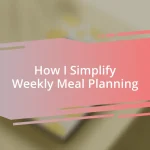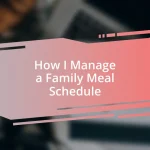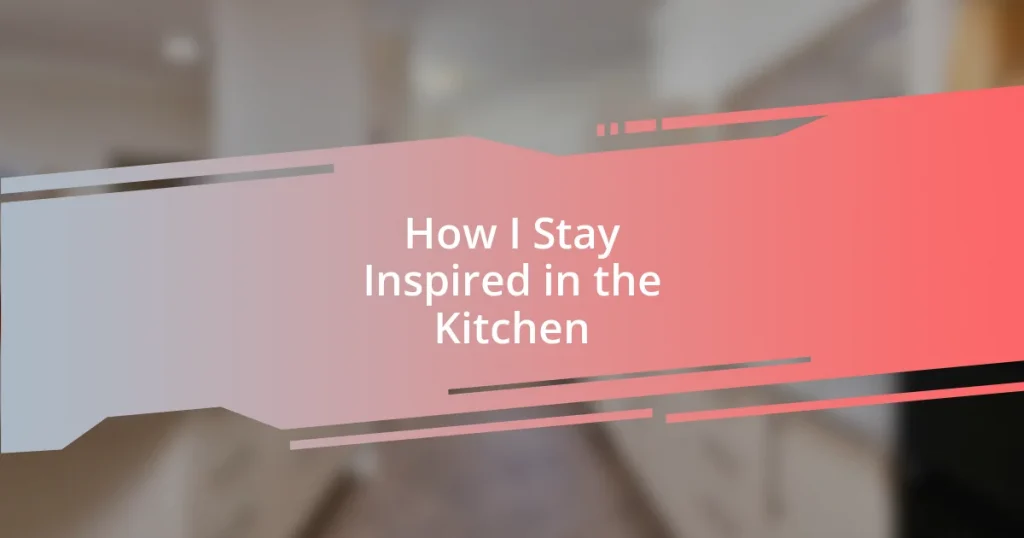Key takeaways:
- Meal planning reduces stress by organizing meals ahead of time, minimizing food waste, and promoting healthier eating choices.
- Assessing the weekly schedule helps effectively allocate time for meal preparation around commitments to avoid last-minute takeout.
- Batch cooking and proper storage of meals ensure they are accessible, maintain freshness, and provide a variety of options throughout the week.

Understanding Meal Planning Benefits
Meal planning has been a game changer for me, especially during those hectic weeks when schedules are packed. I remember one particularly chaotic month when I started planning meals ahead of time. It was incredible to see how something as simple as setting aside an hour for meal prep on Sundays saved me from the daily stress of deciding what to eat amid the whirlwind of life.
By taking time to plan my meals, I not only cut down on grocery shopping trips but also minimized food waste. I can’t tell you how many times I found half-used produce languishing in the fridge, only to toss it out unceremoniously later. Have you ever felt that pang of regret over wasted food? Planning helps me buy only what I need, ensuring everything gets used and enjoyed.
Moreover, I’ve discovered that having meals prepped enhances my overall well-being. Knowing what I’ll eat keeps me from making impulsive, unhealthy choices. Who hasn’t reached for a bag of chips in desperation? Now, when I open the fridge, I see balanced meals ready to nourish me. It not only satisfies my hunger but also makes me feel accomplished and in control of my choices. Isn’t that a win-win?

Assessing Your Weekly Schedule
When assessing my weekly schedule, I find it crucial to take a close look at my commitments and obligations first. I learned early on that trying to plan meals without considering long meetings, social events, or family activities often led to frustration and last-minute takeout orders. Now, I block off time slots where I know I’ll be busy, giving me a clearer picture of which days I can realistically dedicate to cooking.
Here’s what I typically reflect on during this process:
- Work commitments: Identify long meetings or deadlines that require extra focus.
- Family activities: Note any activities that might require a quick meal or snacks on the go.
- Social events: Consider dinners or outings that might impact dinner preparations.
- Personal downtime: Recognize days when you might want to keep cooking light and simple.
- Grocery shopping: Schedule a time to shop when your week allows, ideally before your meal prep day.
By mapping this out, I can weave my meal planning seamlessly into my life instead of fighting against it. I remember a week when I had back-to-back events; by planning lighter meals for those days, I avoided the temptation of fast-food. It felt empowering to stay on track, even when life got busy.

Choosing Quick and Healthy Recipes
Choosing quick and healthy recipes can really transform a hectic week into something much more manageable. I often find myself browsing quick cookbooks or searching online for recipes that take 30 minutes or less. One time, I stumbled upon a fantastic quinoa salad that packed a nutritional punch and was ready in a flash; it became my go-to during busy weeks. The key is finding recipes that not only suit your taste but also align with your health goals, making your cooking experience enjoyable rather than a chore.
In my experience, it helps to categorize recipes based on cooking time, ingredients, and nutrition. I creates a personal database that I can quickly refer to when planning my meals. It’s gratifying to know that I have several ready-to-go meals that require minimal prep. For instance, I’ve experimented with one-pan dishes; not only are they easy, but they also make cleanup a breeze. There’s something really satisfying about enjoying a nutritious meal without hours spent in the kitchen, isn’t there?
What I love is the balance I achieve when combining variety with simplicity in my recipes. The goal is to ensure I’m not eating the same thing every day while still keeping it easy to prepare. I keep a few base ingredients on hand, like brown rice and roasted vegetables, and pair them with different proteins or dressings throughout the week. This way, I can create countless combinations while ensuring each meal is quick, healthy, and something I look forward to!
| Recipe Type | Cooking Time |
|---|---|
| Quinoa Salad | 30 minutes |
| One-Pan Chicken and Veggies | 40 minutes |
| Stir-Fried Tofu and Broccoli | 25 minutes |

Creating a Flexible Shopping List
Creating a flexible shopping list is a game changer for my weekly meal prep. I always start by listing my staple ingredients, but I leave some room for adjustments based on what’s fresh at the store. This way, I’m not only prepared but also inspired by seasonal produce – there’s nothing quite like the excitement of picking up ripe avocados or vibrant bell peppers to spark new ideas for the week.
One tip that works for me is to categorize my shopping list into sections: produce, proteins, grains, and pantry staples. I often think about how much easier it is to shop when I know exactly where to find things in the store. Last week, I forgot to add cucumbers to my list, but since my shopping was organized, I quickly grabbed them when I noticed them in the produce section. It’s those spontaneous choices that often lead to delicious surprises in my meals.
I also make it a point to reassess my list based on what I actually have at home. More than once, I’ve had a scenario where I bought extra ingredients I later realized I could have easily used in a different dish. Setting aside a minute to review my pantry before heading out saves me time and money. Isn’t it a relief to discover creative ways to use what you already have, rather than letting ingredients go to waste? In my experience, maintaining a flexible shopping list not only eases the cooking process but also inspires culinary creativity throughout the week.

Preparing Ingredients in Advance
Preparing ingredients in advance has honestly changed the way I approach meals during busy weeks. One of my favorite prep days is Sunday; I can spend a couple of hours chopping vegetables, marinating proteins, and even cooking grains like quinoa or brown rice. There’s something incredibly rewarding about seeing a fridge filled with neatly organized containers, ready for quick assembly when the evening rush hits.
I remember one time I boiled a batch of eggs, which became a lifesaver throughout the week. Whenever I rushed to get out the door, I would grab an egg and pair it with a handful of mixed greens for a quick salad or toss it into a wrap. It’s little preparations like these that truly make a difference; knowing I have nutritious options within arm’s reach eases the stress of meal times. Does it feel good when you look into your fridge and see ready-to-use ingredients? It definitely does for me!
Another strategy I swear by is bulk prep of versatile items, like roasted vegetables. I usually choose a mix of seasonal veggies to roast on Sunday, and those same veggies can be transformed into various meals throughout the week. One day, they might accompany grilled chicken; another day, they’ll find a home in my breakfast omelet. Isn’t it fascinating how a little prep can lead to so many meal possibilities? For me, it’s this creativity that not only saves time but also keeps the week exciting, allowing me to look forward to meals rather than dread them!

Implementing Batch Cooking Strategies
Batch cooking has enriched my meal planning immensely, and I find it’s all about choosing the right recipes. For instance, I often dedicate a few hours on weekends to cook large portions of dishes like chili or stew. These meals not only fill my fridge but they also heat up beautifully throughout the week, providing comfort food in a flash. Have you ever tasted something that gets better as it sits? That’s the magic of batch cooking; flavors deepen, and you end up with cozy meals at your fingertips.
When I think about what makes batch cooking successful, I can’t help but highlight the importance of proper storage. I invest in a range of containers, from glass to BPA-free plastic, so I can easily store meals in appropriate portion sizes. There’s a particular joy in labeling my containers for the week—knowing exactly what I’m pulling out for lunch or dinner takes away that evening “What’s for dinner?” stress. Doesn’t it feel satisfying to easily grab a prepped meal, knowing you’ve made a mindful choice?
I also encourage blending different cultures into your batch cooking. A few weeks ago, I prepared a big pot of Indian dal infused with spices, alongside a simple Mediterranean grain salad. Not only did it make for a diverse menu, but that combination turned my week into a little culinary journey. Have you tried incorporating flavors from various cuisines? The fun lies in the experimentation, and it can transform cooking from a chore into something exciting and new!

Storing Meals for Easy Access
When it comes to storing meals, I’ve found that using clear, airtight containers is essential. They not only keep food fresh longer but also allow me to see what I have at a glance. On particularly hectic days, just opening the fridge and spotting a colorful salad or a hearty casserole inside gives me an instant sense of relief, knowing a delicious meal is merely minutes away.
I can’t stress enough the joy of labeling containers! Each time I pull one out, it feels like unwrapping a little gift. It’s as if I’m rediscovering a meal I had forgotten about. The simple act of writing the date and contents on the label has saved me from either eating leftovers too late or throwing away something still good. How satisfying is it to enjoy a dish that you know has been thoughtfully stored and is ready for you at the end of a long day?
One trick I love is using stackable containers, which maximize my fridge space. This might sound silly, but arranging them like a mini tower becomes somewhat of a game for me. I feel accomplished when everything is neatly organized, and it encourages me to keep going back for those healthy meals. Do you ever find that a little organization inspires you to eat healthier? For me, it definitely does, and I cherish those moments when I can easily grab a meal and head out the door, feeling prepared for whatever the day throws my way.













